Explore Vietnamese Recipes from Chef, Educator, and Author Andrea Nguyen
- by bonappetit
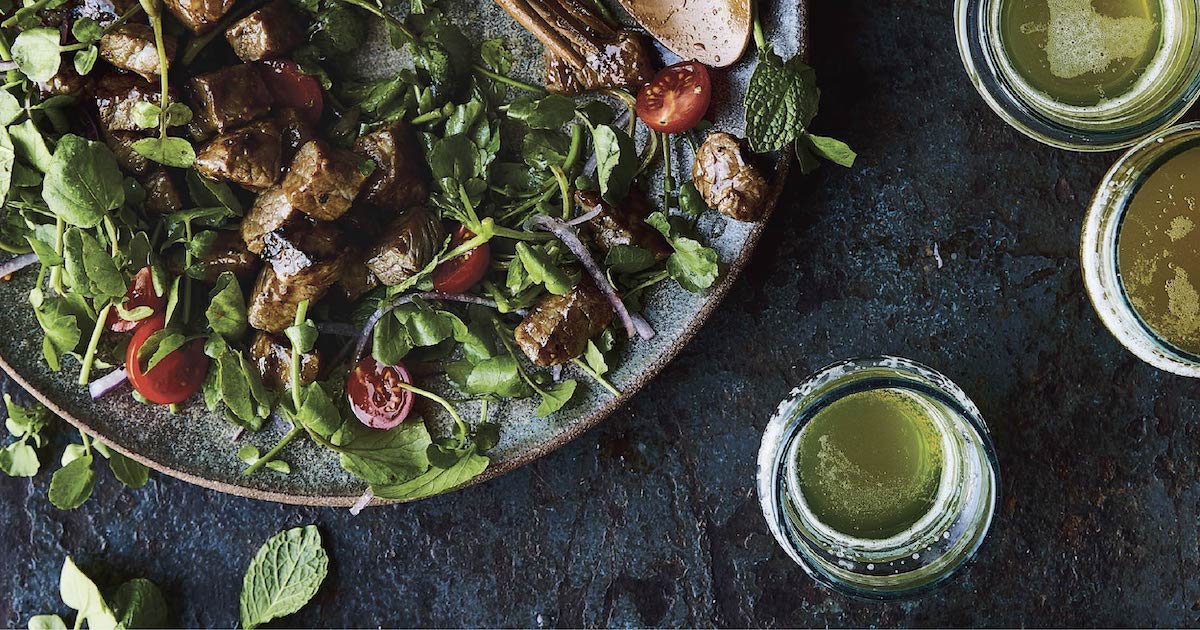
This Asian American Pacific Islander Heritage month, Bon Appétit is partnering with James Beard-award winning chef Andrea Nguyen. As an immigrant from Vietnam who arrived in the United States after the fall of Saigon in 1975, Andrea made it her mission to change attitudes about “exotic” Asian cuisine, working hard to make her community a part of the food conversation. Andrea has been extraordinarily successful, publishing numerous celebrated cookbooks, and being featured in The New York Times, Milk Street Radio, and even the History Channel.
Bon Appétit is excited to be serving recipes from Andrea in our cafés and we encourage you to explore them below.
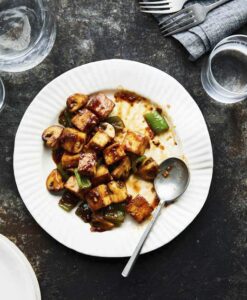
Spicy Sweet Pomegranate Tofu
This earthy, tangy main dish shares the same sauce as the Pomegranate Sriracha Shrimp in my book, Vietnamese Food Any Day, but the tofu, soy sauce, and vegetables turn it into something distinctively delicious. Tofu is typically deep-fried for dishes like this one, but panfrying is a healthier way to inject richness and character. For texture, complexity, and color, I add mushroom and mild-tasting chiles. Anaheims are my go-to but during the warmer months when chiles are in season, I love to use varieties such as Hatch and Corno di Toro. In a major pinch, half a large bell pepper will do. Enjoy with rice.
SERVES 4
14 to 16 ounces extra-firm tofu, water poured from the tub
About 3/4 teaspoon fine sea salt
3 1/2 tablespoons water
2 tablespoons pomegranate molasses
1 1/2 tablespoons soy sauce 1 tablespoon sriracha, plus more as needed
1 1/2 teaspoons to 1 1/2 tablespoons light or dark brown sugar
3/4 teaspoon cornstarch
2 1/2 tablespoons canola or other neutral oil
6 large cremini or white mushrooms, quartered, with stems intact
1/4 cup finely chopped shallot or yellow onion
2 garlic cloves, finely chopped
2 Anaheim, Hatch, or sweet red chiles, trimmed and cut into 1-inch squares
Cut the tofu into 1-inch cubes and season with a rounded 1/4 teaspoon of the salt, then let drain on a double layer of paper towels or a clean non-terry dish towel for 10 to 15 minutes
Meanwhile, in a small bowl, combine the remaining 1/2 teaspoon salt, 3 tablespoons of the water, the pomegranate molasses, soy sauce, and sriracha. Taste and add the brown sugar, starting with 1 1/2 teaspoons, to create a tart sweetness; the amount you use will depend on the flavor of the molasses and your own palate. For more heat, add more sriracha, 1/2 teaspoon at a time. Aim for a tangy-savory-spicy dance of flavors. Set the sauce aside. In another small bowl, stir together the cornstarch and remaining 1 1/2 teaspoons water and set aside.
In a large nonstick or carbon-steel skillet over high heat, warm 1 tablespoon of canola oil. Meanwhile, use paper towel to blot excess moisture from the tofu.
When the oil shimmers, add the tofu and cook for 5 to 6 minutes, turning frequently to brown on two or three sides. Remove from the pan and set aside on a plate.
Add the mushrooms to the hot skillet and cook for 2 minutes, until slightly shrunken, a bit browned, and glistening. Swirl in the remaining 1 1/2 tablespoons canola oil, add the shallot and garlic, and stir-fry for about 30 seconds, until fragrant. Add the chiles and stir-fry for about 1 minute, until slightly softened. Return the tofu to the pan and cook for about 2 minutes, until hot.
Stir the sauce and add to the pan, combining it with the vegetables. Cook at a vigorous boil for 1 minute, stirring, until slightly thickened. Give the cornstarch slurry a stir, pour into the pan, and cook, stirring, for 20 to 30 seconds to thicken the sauce and coat the tofu and vegetables. Transfer everything to a deep plate or shallow bowl and serve.
NOTES
There’s some sputtering with this dish. Put newspaper on the floor next to the stove to make cleanup easier.
Instead of pomegranate molasses, use 1/4 cup homemade tamarind liquid, or 1 tablespoon syrupy tamarind concentrate mixed with 1 tablespoon water.
The tofu can be panfried 4 hours in advance and kept, covered, at room temperature.
Any Day Viet Pickle 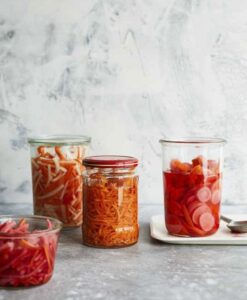
Keep this flash pickle around to add color, crunch, and tang to Vietnamese dishes. Simply called đồ chua (“sour stuff ”), the daikon and carrot pickle is a banh mi must-have and a perfect side for rice plates and grilled meats. You can substitute turnips or watermelon radish for the daikon; the Notes have more ideas. If the pickle turns stinky as it ages, open the jar and let it air out for 15 minutes before using.
MAKES ABOUT 3 CUPS
TAKES 10 TO 30 MINUTES, PLUS 1 HOUR TO MATURE
One 1-pound daikon, or two 8-ounce purple-top turnips or watermelon radishes
One 6-ounce carrot
1 teaspoon fine sea salt 2 teaspoons sugar, plus 1/2 cup
1 1/4 cups distilled white vinegar (preferably Heinz)
1 cup lukewarm water
Peel and cut the daikon into sticks about 3 inches long and ¼ inch thick (the width of an average chopstick). Peel and cut the carrot into sticks a little skinnier than the daikon.
Put both vegetables in a bowl and toss with the salt and 2 teaspoons sugar. Massage and knead for 3 minutes, or set aside for 20 minutes, until you can bend a piece of daikon so the tips touch without breaking. They will have lost about a quarter of their original volume.
Rinse the vegetables with water, drain in a mesh strainer or colander, and press or shake to expel excess water. Transfer to a 4-cup jar.
In a medium bowl, stir together the remaining 1/2 cup sugar with the vinegar and 1 cup water until dissolved. Pour enough of the liquid into the jar to cover the vegetables, discard any excess, and let sit for 1 hour. Use immediately, or refrigerate for up to 1 month.
NOTES
Instead of daikon, use 12 ounces of red radishes. Cut them, unpeeled, into 1/8-inch-thick rounds. Halve the carrot lengthwise, and thinly slice on the diagonal to coax faster pickling. Toss the vegetables in the salt and sugar, let sit for 10 minutes to soften, then rinse and brine as directed.
Don’t like daikon funk? Pickle a 10-ounce package of shredded carrot. Enjoy as is, or mix with sliced green cabbage in a 1:2 ratio of carrot to cabbage, add some of the brine, and season with salt. Let sit for 10 minutes to slightly wilt the cabbage and yield a slaw-like mixture to pair with Viet foods.
Bún Rice Noodle Salad Bowl 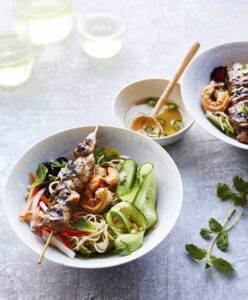
Like banh mi sandwiches, southern Viet rice noodle salad bowls are adaptable and great for healthful, impromptu meals. Often categorized at restaurants as rice vermicelli bowls or bún (the name of the noodles), they’re built on this blueprint: A large bowl filled with ribbons of lettuce and a thin, crunchy vegetable for texture; fresh herbs for pungency; and slippery rice noodles to convey flavors. You get to choose the toppings, which are inevitably garnished with roasted peanuts. A fancy bowl often has pickled radish and carrot for color and crunch plus fried shallots for extra richness (canned fried onions are my lazy-day sub). You dress the bowl with nước chấm dipping sauce, toss it with chopsticks (or a fork) and spoon, then dive in.
To quickly make your own, keep some dried noodles on hand as well as a jar of nước chấm sauce base, washed herbs and lettuce or baby lettuce mix, and roasted nuts. All that’s left is the main attraction. Following is a versatile marinade for beef, pork, and chicken skewers. In the Notes you’ll find more ideas to fuel your creativity.
To grill the meat, you will need skewers. With 6-inch skewers, you’ll fill eight to ten of them; with 10-inch ones, you’ll need four or five skewers. (If using wooden skewers and intending to cook over a live fire, soak them in hot water for 20 minutes.)
SERVES 4
MARINADE
3 garlic cloves, chopped
1/2 cup coarsely chopped shallot or yellow onion
1/4 teaspoon plus 1/8 teaspoon recently ground black pepper
1/2 teaspoon Chinese five-spice powder
1 1/2 tablespoons granulated sugar, or 2 tablespoons packed light brown sugar
1/2 teaspoon molasses or dark amber honey
1 1/2 tablespoons fish sauce
1 teaspoon soy sauce
1 1/2 tablespoons canola or other neutral oil, plus more for grilling
1 1/4 pounds well-marbled beefsteak (such as tri-tip or New York strip steak), boneless pork shoulder, boneless country-style pork ribs, or boneless, skinless chicken thigh
1 (6- to 8-oz) package small dried round rice noodles (maifun), or 1 (10- to 12-oz.) package dried rice capellini or thin spaghetti
1 cup Nuoc Cham Dipping Sauce (see below)
2/3 cup unsalted roasted peanuts or cashew pieces, coarsely chopped if large
1/4 cup fried onions or shallots (optional)
4 cups baby lettuce mix or leaves of soft-leaf lettuce (such as butter, Boston, or green leaf), cut into narrow ribbons, with spines intact
3 or 4 handfuls bean sprouts, or 1 Persian cucumber, shaved with a vegetable peeler into thin strips, or both
1/2 cup hand-torn fresh cilantro leaves and tender tops
1/2 cup hand-torn fresh mint leaves, basil leaves, or dill fronds, or a combination
In a small food processor, combine the garlic, shallot, pepper, five- spice powder, sugar, molasses, fish sauce, soy sauce, and canola oil, then whirl into a slightly coarse, liquid-y marinade. (Or, pound the garlic, shallot, and sugar with a mortar and pestle and mix in the other ingredients.) Transfer the marinade to a large bowl.
If using beef or pork, cut the meat across the grain into strips about 1 inch wide, 3 inches long, and a scant 1/4 inch thick. If using chicken, cut each thigh crosswise into 1-inch-wide strips; if a thigh is super-thick on one end, cut one or two gashes there to even out the thickness before cutting the strips. Add to the marinade, and massage to coat well.
Thread the meat onto the skewers, covering most of each skewer. For succulence, give each loaded skewer a gentle squeeze to ensure that the meat hugs the skewer. Set on a plate, cover, and set aside to marinate at room temperature for 30 to 60 minutes.
Meanwhile, in a pot of unsalted water, boil the noodles until tender; the cooking time depends on the noodle and brand. Drain in colander, rinse with cold water, and set aside to drain well. Put the dipping sauce in a serving bowl. Set the nuts and fried onions (if using) near the stove.
Divide the lettuce and bean sprouts among four large soup or pasta bowls (you’ll need room later to mix and toss). Add the cilantro and mint, reserving 2 tablespoons for garnish. Top with a layer of noodles. Set near the stove.
Right before grilling, lightly spray or brush oil on the meat. Lightly oil a cast-iron stove-top grill pan and set over medium-high heat. Or, prepare a medium-hot charcoal fire or preheat a gas grill to medium-high (you can hold your hand 6 inches above the grill for 3 or 4 seconds).
Cook the skewers for 8 to 12 minutes, turning frequently and basting with oil, until the meat is slightly charred and cooked through. Knick a piece with the point of a knife to check. Divide the meat among the bowls, either keeping it on the skewers or sliding it off. Crown with the nuts, fried onions, and reserved herbs.
Serve the bowls with the sauce on the side. Have diners dress and toss their own bowls.
Nuoc Cham
I’ve been making Vietnam’s ubiquitous nước chấm for decades but I still prepare it in stages to dial in the flavor. Much like making a vinaigrette, taste, taste, taste. Follow this recipe, then create your own blueprint. With the optional additions, choose chile for heat, garlic for pungency, and/or carrot for texture.
MAKES 1 CUP
2 to 2 1/2 tablespoons sugar, or 3 to 4 tablespoons maple syrup
1/2 cup warm water, plus more as needed
3 to 4 tablespoons fresh lime juice
2 tsp. unseasoned Japanese rice vinegar (optional)
3 to 4 tablespoons fish sauce
Optional add-ins
1 or 2 Thai or serrano chiles, thinly sliced (keep seeds intact); or 2 to 3 teaspoons chile garlic sauce or sambal oelek
1 large garlic clove, minced
1/2 small carrot, cut into thin matchsticks or coarsely grated
In a small bowl, combine 2 tablespoons of the sugar (or 3 tablespoons of the maple syrup), 3 tablespoons of the lime juice, and the water. Taste the limeade and, if needed, add the remaining 1 1/2 teaspoons sugar (or 1 tablespoon maple syrup) and/or 1 tablespoon lime juice; dilute with water if you go too far. If there’s an unpleasant tart-bitter edge, add the vinegar to fix the flavor.
Add the fish sauce to the bowl; how much you use depends on the brand and your own taste. Aim for a bold, forward finish that’s a little gutsy. (Keep in mind that this sauce typically dresses dishes that include unsalted ingredients such as lettuce and herbs, which will need an extra flavor lift.) If desired, add the chiles, garlic, and/or carrot. (Offer the chiles on the side if diners are sensitive to their heat.) The sauce can sit at room temperature for up to 8 hours until serving.
NOTES
Lime juice dulls and can turn the sauce slightly bitter when left overnight. For a make-ahead nước chấm, combine the sugar, water, and fish sauce to make a base, then refrigerate for up to 2 weeks. (Prep a double batch, if you use it a lot.) To finish, add the lime juice, vinegar (if using), and any desired add-ins.
For a vegetarian nuoc cham, in a small bowl, stir together a rounded 1/2 teaspoon fine sea salt, 3 tablespoons packed light brown sugar (or 4 to 5 tablespoons maple syrup), and 3 tablespoons fresh lime juice. Taste and add more sweetener or up to 1 teaspoon unseasoned Japanese rice vinegar to round out the lime juice. Add 2/3 cup lukewarm water and 1 1/2 teaspoons soy sauce. Finish with any add-ins before serving.
Shaking Beef 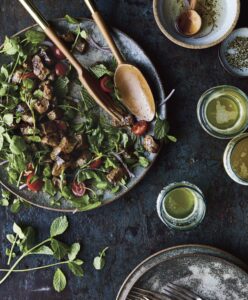
A deliciously quirky combo of warm cubes of seared steak atop a cool salad, this classic is traditionally considered a special-occasion dish in Vietnam, where beefsteak is a luxury. Given that, cooks cleverly cut the meat into smaller pieces to imbue it with flavor, cook it quickly, and serve it to a crowd. The name in Vietnamese, thịt bò lúc lắc, refers to the back-and- forth shaking (lúc lắc) of the skillet as the beef (thịt bò) cooks. Shaking beef is a Viet restaurant favorite, and a cinch to make at home.
For the steak, choose well-marbled pieces. When the beef hits the greens, they wilt slightly and the beef juices and dressing blend together into a tangy sauce, which is great spooned over rice or other grains.
SERVES 4
MARINATED BEEF
1 1/2 teaspoons sugar
1 1/2 teaspoons cornstarch
1/2 teaspoon recently ground black pepper
2 garlic cloves, put through a press or minced and mashed
1 1/2 to 2 tablespoons oyster sauce
1 tablespoon soy sauce
1 teaspoon fish sauce
1 1/2 pounds beefsteak, such as bottom sirloin (tri-tip) or New York strip, trimmed and cut into 3/4 to 1-inch cubes
1 to 2 tablespoons canola oil
SALAD
1/4 cup thinly sliced red onion or shallot
1 1/2 teaspoons sugar or honey
2 pinches fine sea salt
About 4 grinds black pepper
1 1/2 tablespoons unseasoned rice vinegar
2 tablespoons water
4 cups lightly packed watercress, baby arugula, or other salad greens
1/4 cup fresh mint, basil, or other herb leaves, torn (optional)
6 to 8 cherry tomatoes, halved (optional)
Prepare the beef.
In a medium bowl, stir together the sugar, cornstarch, pepper, garlic, 1½ tablespoons of the oyster sauce, the soy sauce, and fish sauce. Taste and, if a saltier finish is needed, add up to 1 1/2 teaspoons oyster sauce. Add the beef, toss to coat well, and let marinate for 20 minutes at room temperature. Keep the canola oil nearby.
Make the salad.
Rinse the onion in a strainer under cold running water for about 10 seconds, then set aside. In a large bowl (suitable for tossing the salad), whisk together the sugar, salt, pepper, vinegar, and water. Add the onion, top with the watercress, and, if you wish, add the mint and tomatoes, but don’t toss.
Set a large skillet that can get very hot (such as carbon steel or cast iron) over high heat and add enough of the canola oil to film the bottom. When the oil is shimmering, carefully add the beef, spreading it out in one layer, and cook for 3 to 4 minutes, shaking the pan every 30 to 60 seconds to sear the beef on all sides; it should be medium-rare. (If you want to minimize mess, cover the pan with a splatter guard, and flip the meat with a spatula.) Remove from the heat.
Quickly toss the salad and transfer everything, including the dressing, to a platter or serving dish. Pile the cooked beef and its juices on top and serve immediately. At the table, ceremoniously combine all the ingredients and invite diners to dive in.
CREDIT
Reprinted with permission from Vietnamese Food Any Day: Simple Recipes for True, Fresh Flavors by Andrea Nguyen, copyright © 2019. Published by Ten Speed Press, an imprint of Penguin Random House.
Photography by Aubrie Pick © 2019